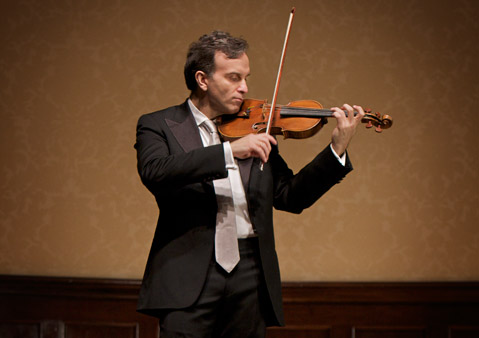Gil Shaham, Violin
All-Bach Recital at UCSB’s Campbell HallThe renowned soloist Gil Shaham will perform pieces by Bach for unaccompanied violin.

A serious musician with a career as a soloist is always thinking in terms of one of two things — developing one’s talent or leaving a legacy. For Gil Shaham, the talent, although it continues to grow, is already there in abundance, so the arc of his career now bends toward the legacy — and it will unquestionably be a rich one.
When he comes to UCSB’s Campbell Hall on Saturday, November 5, as part of the Arts & Lectures classical series, Shaham will play nothing but music by J. S. Bach — Partita No. 3 in E Major (BWV 1006), Sonata No. 3 in C Major (BWV 1005), and Partita No. 2 in D Minor (BWV 1004). He’s working his way through all of Bach’s music for solo violin in a series of recitals right now, but Shaham has been playing the partitas and sonatas for much longer than that in practice. “I just figured it was time,” said Shaham when I spoke to him via phone from his New York City home. “I have been playing these solos all my life, and I thought, ‘Well, I’m not going to get more comfortable playing them in public unless I start doing it.’” Rehearsing, according to Shaham, has been “a joy, because these pieces are almost hypnotic to me. I set aside an hour to practice one, and then I look up and two hours have gone by.”
We are very lucky to get to hear these remarkably personal (and well-rehearsed!) interpretations of the Bach violin solos, as Shaham is only playing them in two places on the West Coast — UCSB and Stanford. It will be interesting to compare what he does with these works to the other Shaham obsession of the moment, a series of concerts with distinguished symphony orchestras around the world exploring violin concertos written in the 1930s. “I had no idea until I really focused on this project what a gold mine this period is for the violin,” said Shaham. “It’s such a concentrated explosion of incredible music, and it’s not even a full decade — more like eight years. And these works are by the best of the best — Samuel Barber, Igor Stravinsky, Alban Berg, Béla Bartók, Paul Hindemith, Benjamin Britten, Arnold Schönberg, and the list goes on.
“The concerto was not as popular before as it became in the 1930s, and there does seem to be a connection to the history of the period. Once when I was in Washington, D.C., playing one of these concerts with the National Symphony, a very distinguished and eloquent patron stopped backstage after the concert to see me,” Shaham said. “He had been alive in the 1930s, and when I told him my theory, which is that people in the period loved the concerto because in it the voice of one is pitted against the voice of many, he replied that ‘it was a time of fear and intensity — like living on the edge of a volcano.’ And I thought that was quite a striking image for the music, as well.”
In an unusual inversion of the ordinary rules of gravity that surround composers and their reputations, it’s the concerto by the least well-known of these 1930s composers that has gotten the most attention. The Concerto Funebre of Karl Amadeus Hartmann is the work of a man whom Shaham describes as “a vocal anti-Nazi critic living in Munich during the Third Reich. The piece is a direct response to his and the world’s tragedy and adversity. We know from his letters. Of all the concertos, this is the only one where we have such a letter, where the composer states his intentions and says, as Hartmann did, that this piece is a response to Hitler or, in particular, the invasion of Czechoslovakia in 1938.”
4•1•1
Gil Shaham performs on Saturday, November 5, 8 p.m., at UCSB’s Campbell Hall. For tickets and information, visit artsandlectures.sa.ucsb.edu or call 893-3535.



